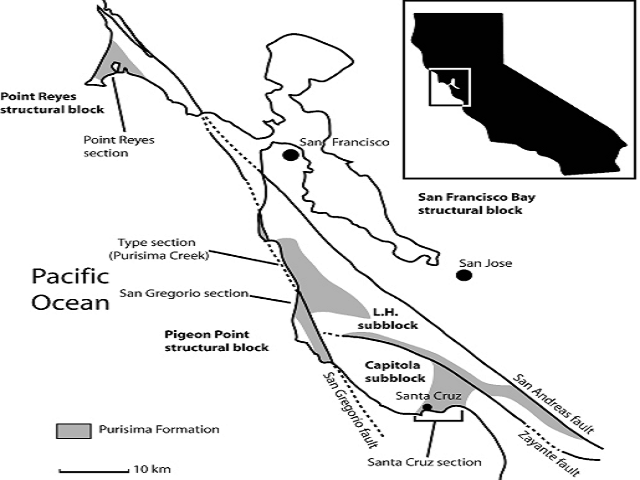A New Marine Vertebrate Assemblage from the Late Neogene Purisima Formation in Central California, Part I: Fossil Sharks, Bony Fish, Birds, and Implications for the Age of the Purisma Formation West of the San Gregorio Fault
Keywords:
Purisima Formation, Pliocene, Miocene, Chondrichthyes, Aves, OsteichthyesAbstract
The Miocene to Pliocene Purisima Formation crops out in multiple transform fault bounded structural blocks in central California. As a result of poor exposure, strike slip fault offset, and uncertain intraformational correlations, some exposures of the Purisima Formation are not well dated. The San Gregorio section of the Purisima Formation occurs in the Pigeon Point Block, west of the San Gregorio Fault, along the coast of southern Halfmoon Bay. Ages based on invertebrate and diatom biostratigraphy support a Late Miocene to Early Pliocene age, while ash correlations indicate a much younger Middle to Late Pliocene (3.3-2.5 Ma) age. Abundant remains of marine vertebrates occur in the Purisima Formation. Recent fieldwork in the San Gregorio section identified a modest assemblage of 26 taxa, including sharks (Carcharodon carcharias, Carcharodon sp., Cetorhinus maximus, cf. Hexanchus, Isurus oxyrinchus, Pristiophorus sp., Squatina sp., and Sphyrna sp.), skates (Raja sp., cf. R. binoculata), bony fish (Paralichthys sp., Thunnus sp.), birds (Mancalla diegensis, Morus sp.), and 13 marine mammal taxa, including several new records for the Purisima Formation. The nonmammalian vertebrates of this assemblage are described herein. The vertebrate assemblage is utilized to evaluate previous biostratigraphic and tephrochronologic age determinations for the San Gregorio section. The stratigraphic range of Carcharodon carcharias, Raja sp., cf. R. binoculata, Mancalla diegensis, and some of the marine mammals strongly indicate a Middle to Late Pliocene age for the upper and middle parts of the section, while a Late Miocene or Early Pliocene age is probable for the base of the sectio





